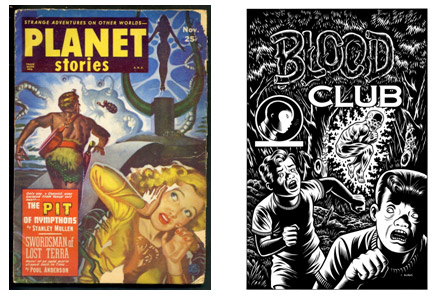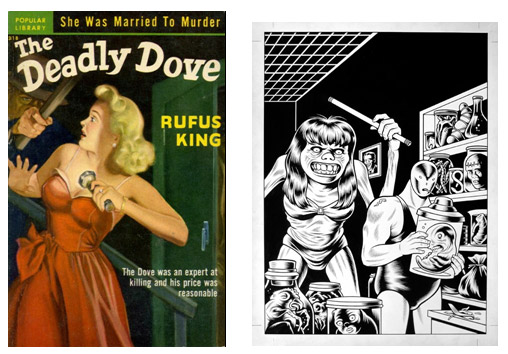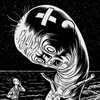| New Perspectives on Illustrationis an engaging weekly series of essays by graduate illustration students at MICA, the Maryland Institute College of Art. Curators Stephanie Plunkett and Joyce K. Schiller have the pleasure of teaching a MICA course exploring the artistic and cultural underpinnings of published imagery through history, and we are pleased to present the findings of our talented students in this weekly blog.Pulp Magazines and Their Influence on Entertainment Today by Mai Ly Degnan explores the connections between popular pulp fiction and contemporary visual culture―from books and comics to the moving image in film, television, and video games. .
Pulp Magazines and their Influence on Entertainment Today By Mai Ly Degnan Pulp magazines have had an incredible impact on pop culture today. Without these long lost lowbrow publications, many of our fiction genres simply would not exist. So much of what we watch in film and television, what we play in video games, as well The very first pulp magazine was made in 1882 and many different pulps ran till the 1950s. The magazines first got their name from the cheap and inexpensive pulp paper they were printed on. They were usually 7×10″ and 128 pages long. The early pulps started off being family friendly, but as the years went by, the art and stories became racier and racier. Because of this, the publication became aimed at a more mature audience. There were pulps for literally ever genre including adventure, mystery, fantasy, science fiction, gangster, horror, romance, spicy, sports, war, and westerns. Pulps were most popular during the 1930s. A lot of this had to do with the Great Depression. Because pulps were so cheap and affordable, they were one of the main forms of Pulps were most known for their exploitative fiction and controversial cover art. Pulp covers were always on higher quality paper and were usually high contrast and brightly saturated colors. The cover art on pulps were so important to the publication, that often times the art was actually made first. After it was made, it was then shown to the authors to come up with the magazine’s content based on that cover artwork. Pulp magazines were definitely for a more adult and mature audience. Every cover was scandalous, over the top, and told its own story in just one image. Pulp cover art, being fantastical and shocking, was a helpful tool when grabbing reader’s attention at newsstands. The idea of “sex sells” was true even back in the pulp era. Much like how moves use action packed trailers to entice an audience, Pulp Magazines also knew exactly how to draw their readers in with provocative cover art. Depending on the genre, most covers contained the typical scantily clad damsels in distress, and male heroes coming to their rescue. Since crime was constantly o the minds of many people during the 1930s, it is only natural that it was such a prevalent theme in both pulp magazine content and cover art. Gender roles also played a regular part in pulp fiction. Iconic male hero characters like Doc Savage, The Phantom Detective, and The Shadow actually had serialized pulps devoted to their stories. This was certainly a precursor to the superhero comics that we know and love today. It is said that the classic Batman character is actually heavily based on the Shadow, which started in 1931. Later, in 1939, Bob Kane and Bill Finger created the first Batman comic. Finger has publicly stated that the first Batman story was based on “Partners of Peril,” a Shadow pulp that was written by stand in author, Theodore There are man similarities between Batman and the Shadow. Both characters work mostly at night, and both are crime fighting vigilantes, who’s alternate egos are wealthy playboys in town. They even share similar aesthetics in their character designs. Both characters are disguised protecting their actual identity from the public. The Shadow was often depicted with a black cape and the bottom half of his face covered. Similarly, Batman is also shown in a cape with the upper half of his face covered by a mask. Both characters have signature headpieces. The Shadow had his black slouch  Sadly the Pulp Era ended for a number of reasons. Many pulps went out of business due to World War 2 paper shortages. They also became less sought after when paperbacks, comics, television, and movies started becoming popular. Needless to say, pulp magazines paved and shaped the way for many of our creative thinkers today.Even though it has been decades, these same themes have crossed over into ever form of entertainment. From television to comics, much of our entertainment has been influenced in some way by pulp magazines. An example of this can be clearly seen in the work of contemporary comic book artist, Charles Burns. Pulp themes are incredibly prevalent throughout much of his subject mater and imagery. Many of his illustrations resemble a number of pulp magazine covers except with the stereotypical gender roles reversed. Burns is known for his creepy horror illustrations and stories. His style is bold and immediately recognizable. Usually with black and white, Burns illustrates with extreme contrast between light and shadow. Many of the topics Burns emphasizes would have definitely made it on to pulp magazine covers, had he been working during the era. Distress is probably the most common theme that crosses over all genres in pulp magazines, and though Burns uses this theme often, he does not conform to stereotypical representations of the helpless woman in the 1930s. Instead, Burns turns the tables by often making the female the stronger, more powerful character.  Pulp Covers were known for their tight, action packed compositions and usually focused on one or two characters. There are a number of dynamic pulp covers where there something explosive is happening in the background, and the foreground characters are funning for their lives. Charles Burn’s Blood Club illustration is compositionally very similar to the Planet Stories cover. Both illustrations focus on the main characters in the foreground and especially on the sheer terror on their faces. Though side-‐by-‐side these illustrations look incredibly similar, there are still some key differences when it comes to gender roles. The pulp cover has a beautiful woman running for cover, while a musical man is being the hero by throwing a grenade at the monster terrorizing the city. In contrast, Burn’s illustration shows two average looking boys running away in complete terror. The boys are not particularly handsome or muscular, nor are they even trying to defend themselves from the chaos happening in the background.  Monsters were a common theme in both sci-‐fi pulp magazines and Charles Burn’s work. The idea of dangerous creatures often represented the fear of the unknown. The left pulp image is of a giant centipede terrorizing a city, where as the right image shows a hideous monster like creature with human like qualities. Both of these images, though different creatures and in different settings, share similar compositions as well as evoke the same anxious feelings of danger and loss of control.  Ambush is another popular theme in pulp cover art, especially in the mystery and detective genres. Scantily clad women were almost always used in these kinds of pulps. The left pulp cover, from The Deadly Dove, shows a man who’s face is partially covered, attacking a beautiful, pin up like woman in a tight dress, from the shadows. He is cropped off the page and holding a wooden stick as a weapon. The lady is clearly in distress and basically helpless. The only weapon she has in her hand is a flashlight. The same action is happening in Charles Burn’s illustration, except here, the gender roles are reversed again. The attacker is both woman and scantily clad, but instead of being beautiful, se is actually a grotesque monster holding a lead pipe, and the victim is actually a 400 lbs. male private eye detective, known as El Borbah. By comparing Burn’s illustrations to pulp cover art, it is obvious that there is a distinct influence. Burn’s compositions and subject matter is distinctly reminiscent of the Pulp Era, yet he has reversed many of the gender stereotypes as well as avoided the need to idealize characters. Perhaps much of this has to do with feminist movement of the 1960s, and how gender roles have changed since pulp magazine was in its hay day. Works Cited “Pulp Magazines.” American Decades. 2001. Retrieved December 10, 2012. http://www.encyclopedia.com. “Anthem Magazine.” Interview. Anthem Magazine. 10 Mar. 2012. Web. 10 Dec. 2012. http://anthemmagaine.com/charles-burns-interview/. “Charles burns.” Interview by Sammy Harkham. VICE. VICE, 2010. Web. 11 Dec. 2012. http://www.vice.com/read/Charles-burns-640-v17n12 “History of the Pulps.” Pulpworld.com. Web. 11 Dec. 2012. http://www.pulpworld.com/history/history_01.htm. Lee Server, Danger Is My Business: An Illustrated History of the Fabulous Pulp Patterson, Frank, and Kevin Burton Smith. “El Borbah.” Review. Thrilling Detective. Web. http://www.thrillingdetective.com/eyes/el_borbah.html. Ron Goulart, Cheap Thrills: An Informal History of the Pulp Magazines New “The Pulp Story Uncovered.” PULP Uncovered. Web. 9 Dec. 2012. http://www.pulpuncovered.com/pulp. Tony Goodstone, ed., The Pulps,: Fifty Years of American Popular Culture New Robinson, Frank M., and Lawrence Davidson. Pulp Culture: The Art of Fiction Magazines. Portland, Or.: Collectors, 1998. Print. |


